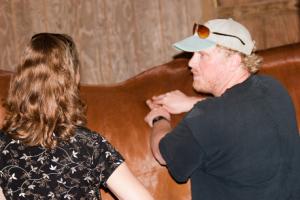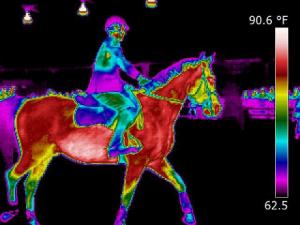By Pam Gamble
Billy Anderson, Memphis area English saddle fitter and Equine Sports Massage Therapist, met with Lenee Allison at her home in Eads, TN in April. Lenee’s new saddle was “in” and Billy was checking for a proper fit. On site for additional consultation was Leigh Ballard, Equine Thermographer with her FLIR infrared thermal imager.
The story began over a month before. Lenee was having problems with her English saddle slipping to one side, so severely that she couldn’t use the saddle at all. This was a real problem since she was planning to show in the English classes in the APHA circuit.
Billy took one look at her English saddle and determined that the air panel had “blown out” or completely deflated. This was disappointing, as the saddle was only two years old and considered top of the line. After pondering her options, Lenee decided to buy a new saddle and Billy began in-depth back tracings of her Paint mare, Ellee.
Saddle fit back tracings are a series of equine back tracings including “rocker panel” tracings. Billy explains, “A tracing of just the withers alone is not enough. It takes a series of tracings; each is four inches behind the one before. The first one, A, is in the pocket, which is roughly two fingers behind the scapula, or shoulder blade. Each subsequent one, B through E, gives additional detailed information to the saddle maker.
“I then take the rocker panel tracings, which show how much cancavity is in the horse’s back. It looks a bit like a tracing of the bottom of a rocking chair, depending on how much dip is in the horse’s back. The rocker panel tracing is absolutely necessary for a full picture of the back. The image that emerges is a three dimensional representation of the horse’s back. When experienced saddle makers get the tracings, they are the next best thing to the horse being there in person.”
These tracings, along with traditional photos of the horse’s back, were sent to Smith-Worthington Saddlery for a new all purpose English saddle. Billy insists, “It is important for the client to make their own decisions regarding the brand of saddle that they want. There are many nice saddles out there. But for the money, you can’t beat Smith-Worthington. They make their saddles with traditional gusseted wool flocked panels. They are the oldest saddle-maker in the United States.” Billy smiled, “They were around when George Washington was President.”
Smith-Worthington can make a completely custom saddle for clients, who can choose flap length and width, seat depth, and different types of leather. Or, they can take a ready-made saddle and adjust it to your horse. Billy sends the tracings to Smith-Worthington and they adjust the tree and possibly the wool flocking for the individual horse.
Billy emphasizes, “There is no comparison to a wool-flocked saddle. It can mold to your horse’s back. It can be adjusted and redone multiple times as the horse’s age and body condition changes. A good fitting wool flocked saddle is the nicest thing you can do for your horse’s back.”
Billy usually confers several times with a client on a typical saddle fit. This includes the final check to see if the saddle is fitting properly. Lenee rode her Paint horse mare in her new saddle so Billy could see how it settled on the mare’s back. Lenee rode in both directions; walked, trotted, and cantered and even did a counter-canter. Billy determined that Lenee’s saddle was a good fit for both her and her mare.
One of the things that he was particularly looking for is “bridging.” Bridging is a condition in which the saddle does not meet the horse’s back, usually mid-tree or at the twist. In other words, the front of the saddle touches the horse and the back of the saddle touches the horse, but the middle will bridge, causing painful pressure points.
Saddle fitters like Billy Anderson usually determine the fit of a saddle with their eyes and hands instead of a camera. So, after the ride Leigh Ballard took thermal images of the mare’s back and the underside of the saddle with her thermographic camera. Leigh agreed with Billy, “The new saddle looks like a good fit. The thermal patterns created by pressure on the horse and on the saddle are even and symmetrical, except for the pattern during the counter canter. The camera is so sensitive that it picked up the difference in leg pressure between the right and left flaps that occurred during the counter-canter,” Leigh said.
Leigh added, “A proper saddle fit is an important component of a horse’s performance. Behavioral and attitude problems can sometimes be caused by ill-fitting saddles. What Billy does with custom fitting new saddles is wonderful. But a horse’s musculature can change with work, and thermal imaging can be used for periodic checkups to make sure a saddle continues to fit over time, or whether adjustments are needed. This is especially good with used saddles. If a horse’s owner is unsure of an existing saddle’s fit, Thermal Imaging can answer these questions.”
For thorough saddle fitting, both types of equine professionals can check the fit of an existing saddle from two perspectives. Once a saddle has been determined not to fit and to need adjustments, the saddle fitter’s job begins. He can assist in ordering a new saddle and communicate with the saddle fitter with possible adjustments. He sends the back tracings, and also communicates any special needs to the saddle manufacturer.
For more information or to schedule an English saddle fit, call Billy Anderson at 901-237-2360. For Equine Thermography, call Leigh Ballard at 901-490-3505.
Billy Anderson, Memphis area English saddle fitter and Equine Sports Massage Therapist, met with Lenee Allison at her home in Eads, TN in April. Lenee’s new saddle was “in” and Billy was checking for a proper fit. On site for additional consultation was Leigh Ballard, Equine Thermographer with her FLIR infrared thermal imager.
The story began over a month before. Lenee was having problems with her English saddle slipping to one side, so severely that she couldn’t use the saddle at all. This was a real problem since she was planning to show in the English classes in the APHA circuit.
Billy took one look at her English saddle and determined that the air panel had “blown out” or completely deflated. This was disappointing, as the saddle was only two years old and considered top of the line. After pondering her options, Lenee decided to buy a new saddle and Billy began in-depth back tracings of her Paint mare, Ellee.
Saddle fit back tracings are a series of equine back tracings including “rocker panel” tracings. Billy explains, “A tracing of just the withers alone is not enough. It takes a series of tracings; each is four inches behind the one before. The first one, A, is in the pocket, which is roughly two fingers behind the scapula, or shoulder blade. Each subsequent one, B through E, gives additional detailed information to the saddle maker.
“I then take the rocker panel tracings, which show how much cancavity is in the horse’s back. It looks a bit like a tracing of the bottom of a rocking chair, depending on how much dip is in the horse’s back. The rocker panel tracing is absolutely necessary for a full picture of the back. The image that emerges is a three dimensional representation of the horse’s back. When experienced saddle makers get the tracings, they are the next best thing to the horse being there in person.”
These tracings, along with traditional photos of the horse’s back, were sent to Smith-Worthington Saddlery for a new all purpose English saddle. Billy insists, “It is important for the client to make their own decisions regarding the brand of saddle that they want. There are many nice saddles out there. But for the money, you can’t beat Smith-Worthington. They make their saddles with traditional gusseted wool flocked panels. They are the oldest saddle-maker in the United States.” Billy smiled, “They were around when George Washington was President.”
Smith-Worthington can make a completely custom saddle for clients, who can choose flap length and width, seat depth, and different types of leather. Or, they can take a ready-made saddle and adjust it to your horse. Billy sends the tracings to Smith-Worthington and they adjust the tree and possibly the wool flocking for the individual horse.
Billy emphasizes, “There is no comparison to a wool-flocked saddle. It can mold to your horse’s back. It can be adjusted and redone multiple times as the horse’s age and body condition changes. A good fitting wool flocked saddle is the nicest thing you can do for your horse’s back.”
Billy usually confers several times with a client on a typical saddle fit. This includes the final check to see if the saddle is fitting properly. Lenee rode her Paint horse mare in her new saddle so Billy could see how it settled on the mare’s back. Lenee rode in both directions; walked, trotted, and cantered and even did a counter-canter. Billy determined that Lenee’s saddle was a good fit for both her and her mare.
One of the things that he was particularly looking for is “bridging.” Bridging is a condition in which the saddle does not meet the horse’s back, usually mid-tree or at the twist. In other words, the front of the saddle touches the horse and the back of the saddle touches the horse, but the middle will bridge, causing painful pressure points.
Saddle fitters like Billy Anderson usually determine the fit of a saddle with their eyes and hands instead of a camera. So, after the ride Leigh Ballard took thermal images of the mare’s back and the underside of the saddle with her thermographic camera. Leigh agreed with Billy, “The new saddle looks like a good fit. The thermal patterns created by pressure on the horse and on the saddle are even and symmetrical, except for the pattern during the counter canter. The camera is so sensitive that it picked up the difference in leg pressure between the right and left flaps that occurred during the counter-canter,” Leigh said.
Leigh added, “A proper saddle fit is an important component of a horse’s performance. Behavioral and attitude problems can sometimes be caused by ill-fitting saddles. What Billy does with custom fitting new saddles is wonderful. But a horse’s musculature can change with work, and thermal imaging can be used for periodic checkups to make sure a saddle continues to fit over time, or whether adjustments are needed. This is especially good with used saddles. If a horse’s owner is unsure of an existing saddle’s fit, Thermal Imaging can answer these questions.”
For thorough saddle fitting, both types of equine professionals can check the fit of an existing saddle from two perspectives. Once a saddle has been determined not to fit and to need adjustments, the saddle fitter’s job begins. He can assist in ordering a new saddle and communicate with the saddle fitter with possible adjustments. He sends the back tracings, and also communicates any special needs to the saddle manufacturer.
For more information or to schedule an English saddle fit, call Billy Anderson at 901-237-2360. For Equine Thermography, call Leigh Ballard at 901-490-3505.










